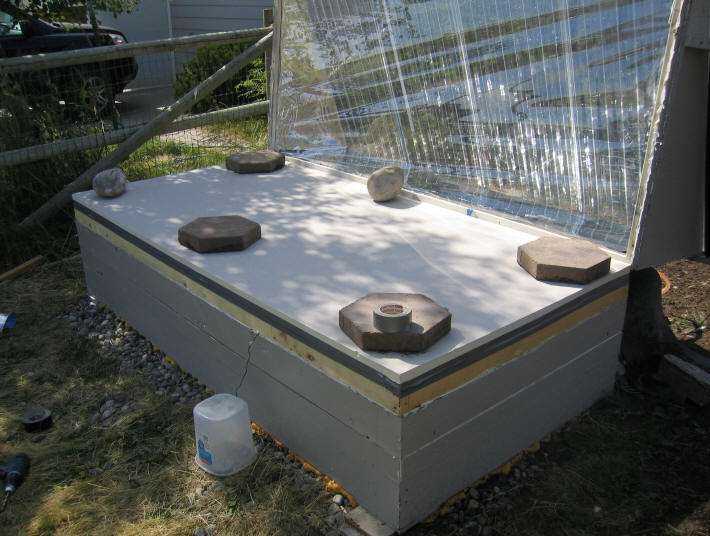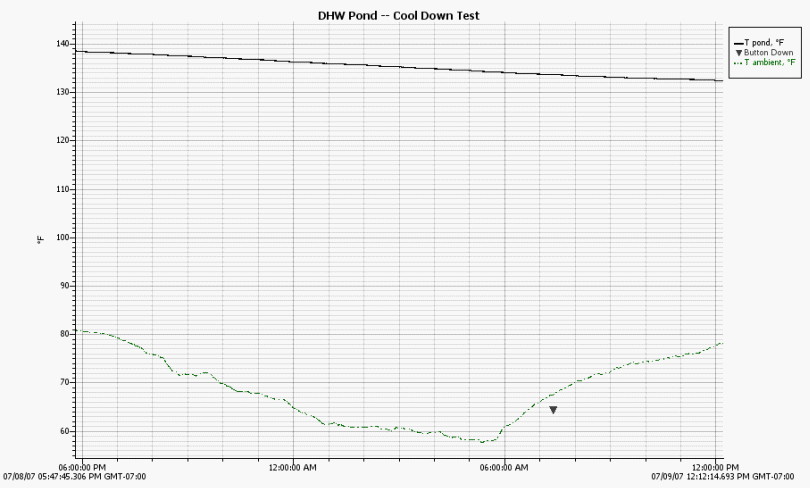
Search
The Renewable Energy site for Do-It-Yourselfers
Cool Down Test
Goal: To try and identify the
discrepancy between actual cool down rate of the pond and the rate calculated
based on R value.
It seems like the most likely
possibility is that the larger than anticipated heat loss has something to do
with the lid and absorber configuration.
To verify this, I opened the top
cover glazing, and installed a 2 inch sheet of polyiso right over the top of the
absorber. To eliminate any air infiltration, it is weighted down, and then
sealed around the edges with duct tape.

The extra layer of insulation over
the existing lid/absorber. Rocks to keep pressed against the edge lip of
absorber, and duct tape just ot make sure.
This should cut the loss per sqft
through the lid to at least as low as the loss through the walls and bottom.
If this reduces the loss to near the
calculated value, then we can be pretty sure the excess loss is due something
going on with the lid/absorber, water vapor, ...??

This is the overnight cool down --
black line is pond temperature, green is ambient.
The inside area of the pond box with
the new sheet in place is 82.3 sqft.
The published R value for 2 inches of
Atlas R-board is R12.1 (US)
Some temperature values extracted
from the plot above:
| Time |
T pond (F) |
T ambient (F) |
| 6pm 07/08/07 |
138.5 |
80.6 |
| 9pm |
137.5 |
71.8 |
| 12 midnight |
136.4 |
64.9 |
| 3am |
135.3 |
60.6 |
| 6am |
134.1 |
60.9 |
| 9am |
133.2 |
72.2 |
| 12 noon |
132.5 |
77.7 |
Actual Loss rate:
Using the time span from 12 midnight
to 6am
Q loss rate = (136.4F -
134.1F)(190 gallons)(8.3 lb/gal)/ (6 hrs) = 605 BTU/hr
The average ambient temperature for
this time span is about 61F, and the average pond temperature is 135.2F.
The effective R value is then:
Q = A dT/R or R = A dT/Q
R = (82.3 sqft) (135.2F - 61F) / 605
BTU/hr = R 10.1
This is at least 20% worse than what
would be expected, but its a lot closer than the factor of 1.8 that I was
getting before. So, it seems safe to conclude that most of the excess heat
loss problem is in the lid, absorber, drains, pump outlet, lower glazing area?
If you assume that R10 could be
obtained with some improvements (below) to the lid configuration, then the total
heat loss for a 16 hour cool season night with a tank temp of 120F and an
ambient of 40F would be:
Q typical night = (82.3 sqft)(120F -
40F)/R10 = 658 BTU/hr or 10500 BTU for 16 hour overnight.
Seems like more than you really want,
given that the gain for a good day is not likely to be more than 26K BTU, and
the demand might be near 15K BTU.
Could:
- Insulate better?
- Add more
collector?
- Reduce tank size
and surface area to decrease losses?
It seems like some increase in
collector area would be a good idea -- it is just barely adequate at best.
I am wondering why we need a tank as
large as 190 gallons -- this is 4 to 6 days supply of hot water for two people.
Wouldn't two or three days be enough?
Making the tank smaller would reduce
losses and costs, and allow higher insulation levels without running the cost up
too much? Maybe the big base, small tank configuration?
This still leaves the problem of
figuring out why the loss is so much greater without the extra lid on the top.
Things that might be done to reduce
losses:
- Terminate the
drains under the pond water surface per Nick
- Put floating
insulating caps on the tops of the drain pipes per Alan
- Figure out a way
to get the absorber pond to drain fully
- Add a layer of
vegetable oil to top of pond as suggested by Jeroen
- Others ideas?
--
On another subject, I have noticed
white deposits on the EPDM absorber surface. These look to me like mineral
deposits from the water? They are pretty significant considering that the
collector has only been in operation for a few days. Easy to rub off with
a finger.
Use demineralized water?
I've also been wondering if (given
the high stagnation temps on the absorber surface) if a metal absorber could be
worked out that would not add significantly to cost and complexity?
Gary 7/9/2007


